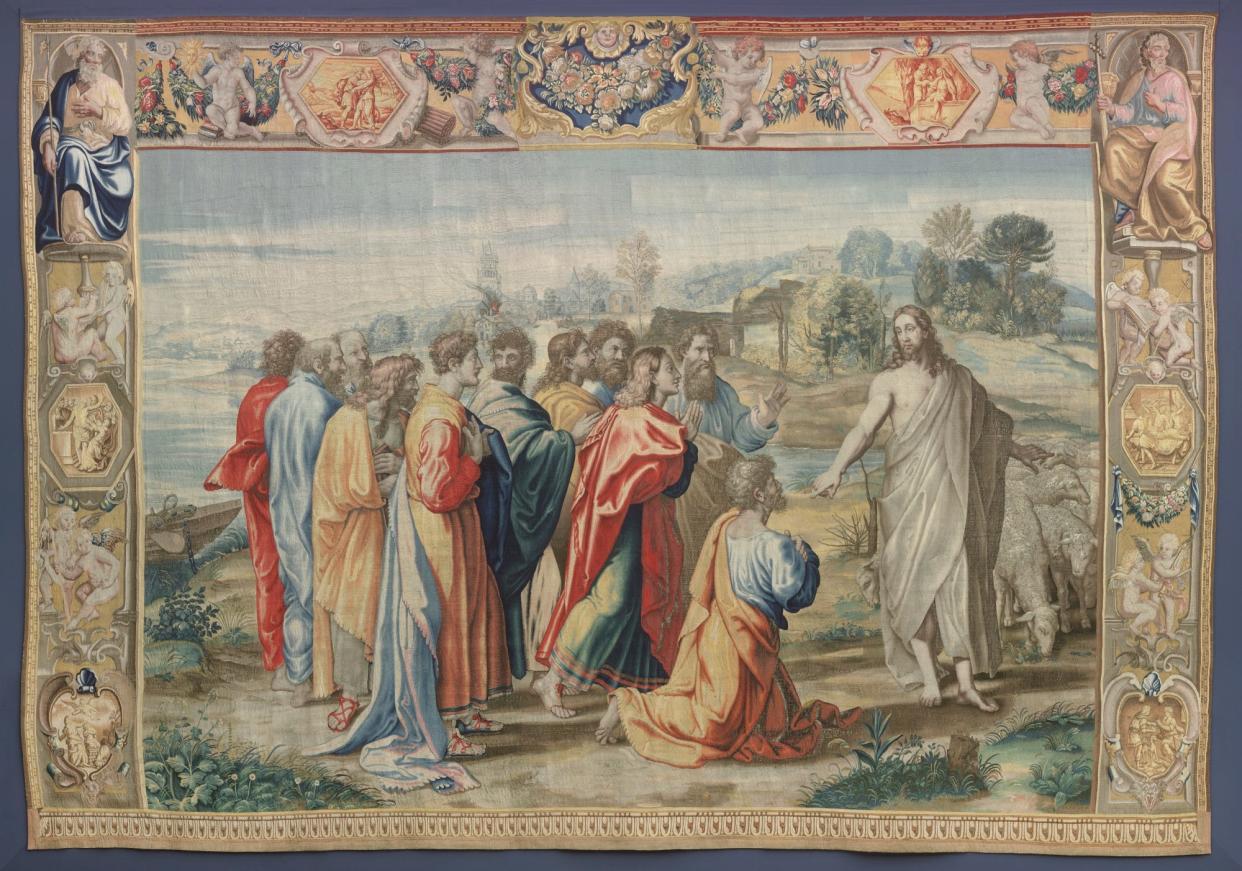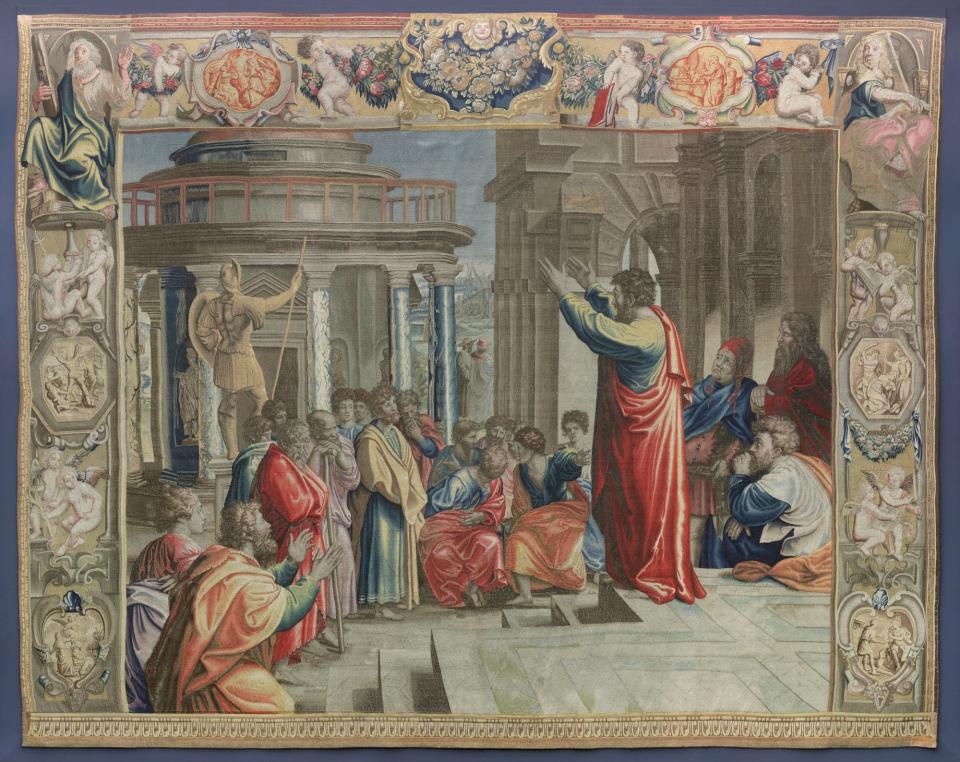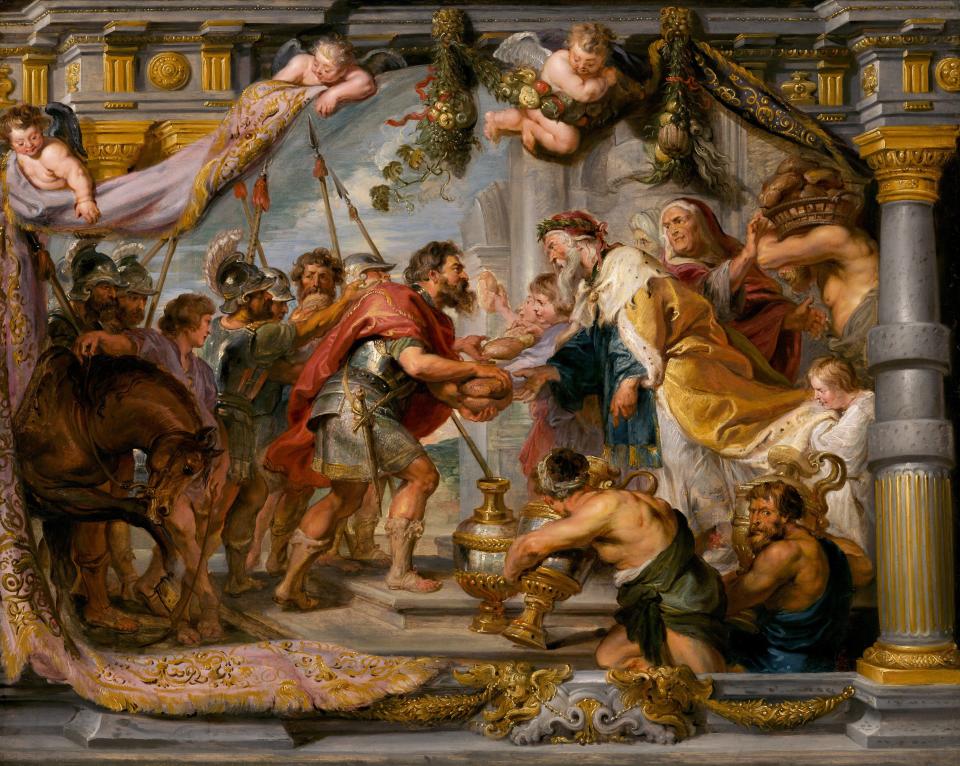Visual Arts: Exhibit's Raphael tapestries weave powerful New Testament stories

- Oops!Something went wrong.Please try again later.
- Oops!Something went wrong.Please try again later.
Six enormous, stunning tapestries designed by the Italian Renaissance master Raphael are being shown for the first time in the United States at the Columbus Museum of Art.
“Raphael — The Power of Renaissance Imagery: The Dresden Tapestries and their Impact,” which continues through Oct. 30, is a collaboration between the Columbus museum and the Dresden, Germany, museum Gemäldegalerie Alte Meister (GAM). The Columbus museum is the first and only U.S. venue for the tapestries which, most likely, will not travel to the U.S. again for decades.
Visual arts: Latinx art more than craft and pop culture, as shown in 'Diálogos' exhibit
The tapestries, each about 20 feet tall and depicting New Testament scenes involving the apostles Peter and Paul, are the focal points of this multi-layered exhibit. Also included are two reproductions of Raphael’s tapestry preparatory paintings — called cartoons — as well as nearly 50 additional paintings, drawings and sculptures inspired by the tapestries or reflecting the widespread influence of the young artist.
Raphael: Renaissance artist designed tapestries for Vatican's Sistine Chapel
Raphael, born Raffaello Sanzio of Urbino, Italy, was an impressively productive and renowned artist during his short life. Along with Leonardo da Vinci and Michelangelo, he was part of the trinity of masters of the period. In 1520, at the age of 37, Raphael died of a sudden illness, probably syphilis.
About 1516, Raphael finished the cartoons for the tapestries, commissioned by Pope Leo X to hang in the Vatican’s Sistine Chapel in Rome. The Dresden tapestries were another set of the works created after the artist’s death. They have had numerous owners and patrons including England’s Charles I, who established the London factory where the Dresden tapestries were woven.

At the Columbus Museum, the tapestries are hung on the second floor of the Walter Wing, the only part of the museum “with enough height to show them,” according to Museum Executive Director Nannette V. Maciejunes.
Stephan Koja, director of Dresden’s GAM museum who accompanied the tapestries to Columbus, said, “They look better here than they did in Dresden.”
The tapestries, which were restored from 1991 to 2003 in Dresden, are brilliant in color, texture and narrative composition. They are regal and imposing, full of detail and surrounded by borders with floral motifs, coats of arms and more.
“The Miraculous Draft of Fishes” is a seaside scene depicting Jesus recruiting Peter and Andrew as disciples as others in boats behind them pull fish from the sea. “Paul Preaching at Athens” shows the converted Saul addressing a crowd whose members look to be skeptical, entranced or on their way to becoming true believers.
Plant-imals: Want to see exotic animal topiaries? 25 are on the prowl at Franklin Park Conservatory
In “Christ’s Charge to Peter,” the kneeling disciple stretches his hands toward Jesus. In the Vatican tapestry, Peter is holding a set of keys, not present in the London-woven tapestry, as authorities had that symbol of Catholicism eliminated.
Raphael drawings, cartoons show tapestries' preliminary designs
Interspersed with the tapestries are the full-size reproductions of Raphael’s cartoons and two small Raphael drawings that preceded the cartoons; a variety of works by Baroque and Renaissance artists that reinterpret the scenes of the tapestries or present other Biblical scenes, and portraits of individuals instrumental in producing or acquiring the tapestries. Among these: Anthony Van Dyck’s 1637 portrait of King Charles I, Peter Paul Rubens’ 1626 painting “The Meeting of Abraham and Melchizedek” and, serendipitously, a massive 17th century painting by an unknown artist, “The Miraculous Draft of Fishes,” from the Carlo Croce Collection in Columbus.

The many dimensions to the art works in the exhibit, as well as informative panels and multi-media enhancements, make for a rich viewing experience. Through cell phones, visitors can access audio narration and video clips that provide more history and context.
Gallery closing: Sherrie Gallerie to close its doors after 36 years in the Short North
Rounding out the experience is the gallery’s soundtrack of recorded period music supplied by two Columbus-based groups: the Fior Angelico chamber chorus that performs 16th and 17th century music, and The Early Interval, dedicated to Renaissance and Baroque music performed on historical instruments.
As Maciejunes noted, the collection of and many exhibits at the Columbus Museum of Art are primarily focused on modernism. The Raphael tapestries offer something of a museum rarity: a vivid and thoughtful look at old masterworks.
At a glance
“Raphael — The Power of Renaissance Imagery: The Dresden Tapestries and their Impact” continues through Oct. 30 at the Columbus Museum of Art, 480 E. Broad St. Hours: 10 a.m. to 5 p.m. Tuesdays through Sundays, until 9 p.m. Thursdays. Admission: $10 special exhibit fee plus regular admission of $18 adults, $9 senior citizens, students and ages 4 to 17, free for age 3 and younger and members; free Sundays; $5 Thursday evenings (with special exhibition admission $5 Thursday evenings); free to veterans and active military and their families. Parking costs $7. Call 614-221-6801 or visit www.columbusmuseum.org.
This article originally appeared on The Columbus Dispatch: Raphael tapestries at Columbus Museum of Art in only U.S. exhibit

